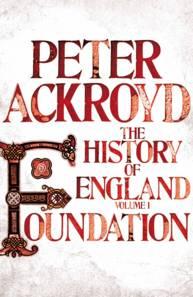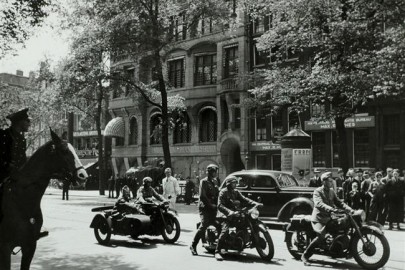A renowned novelist, biographer and critic, Peter Ackroyd is one of Britain’s greatest living writers. His latest project is the epic, six-volume A History of England, the first volume of which, Foundation, takes us from England’s distant prehistory to the death of Henry VII in 1509, and is published in hardback today.
In an exclusive extract for The Dabbler, Ackroyd looks at the historical importance of the English climate…
Climate Change
The climate of England has been characterized as generally damp and relatively sunless but, as every native knows, the weather is as various as the land. In the south-east the summers are warm and the winters are cold, while in the north-west the winters are mild and the summers are cool. In the north-west four and a half hours of sunshine light up an average July day, while on the south coast six and a half hours can be anticipated; the western seaboard attracts 40 per cent more rainfall than the eastern. The predominant wind of autumn and of winter is from the south-west; in the spring it is the east. This was the weather that created a land of damp forests of oak and ash, of marshes and heath wrapped in mist. In the north and the west lay the moors and the mountains, where the soil was thin. This was the land of pasture rather than of crops, and the local farmers grew only as much corn as they needed for themselves. The south and east were the lowlands, with gradual undulations in the rich earth; this was ground as fit for corn as for cattle. It was the territory of ‘mixed farming’.
In the history of England these patterns of climate are of the utmost importance; if there is a drop in temperature of two degrees, as in the period from 500 to 300 bc, the prospect of adequate harvests in the north is noticeably curtailed. A difference of one degree made a failure of the harvest seven times more likely. In this period, then, we see the abandonment of upland farms and settlements. The southern land was warmer, and more stable; it was the home of the plentiful harvest, and the general dampness meant that crops could even be grown on lighter soils where sand and chalk prevailed. It is a general truth, therefore, that in the south-east the land was devoted to wheat whereas in the north it was given over to oats. But important regional variations were still found. Oxfordshire and north-east Suffolk grew wheat, whereas Norfolk grew more rye. Oats were the main crop in Lancashire, while rye was dominant in Yorkshire. Wheat and barley shared the ascendancy in Wiltshire whereas, in the rainier country west of that shire, barley predominated.
The people of the south were wealthier if not healthier than their counterparts in the north. So the climate is active in human history. It may also be that the drier east creates human communities different from those of the rainier west; marked contrasts of social systems in the first millennium bc are in fact evident, with small centres of lordly power in the west and more scattered settlements in the east. The isolated farmhouse and the small hamlet were characteristic of the north and west; the village and the manorial system of common cultivation were more usual in the south and east.
At the time of the Roman occupation the weather was warmer than at any period in subsequent history, but this was succeeded by colder and wetter conditions by the end of the fourth century. For ten years, beginning in ad 536, there was a very low level of sunlight; this would have been a time of dearth and famine, hitherto unrecorded. It might also be noted that Alfred was credited with the invention of a clock that allowed him to tell the time when the prevailing fogs obscured the sun.
The climate of 1009 and 1010 was recorded by a Benedictine monk, Byrhtferth, who dwelled in East Anglia; the winter lasted from 7 November to 6 February, being cold and moist; the spring from 7 February to 8 May was moist and hot; summer from 9 May to 6 August was hot and dry; autumn from 7 August to 6 November was dry and cold. He was only one of the clerics who kept a detailed record of the conditions of the weather.
The eleventh and twelve centuries were in fact warmer than those immediately preceding them, but a deterioration of climate took place in the thirteenth and fourteenth centuries; the annals of these later centuries also mention the increasing incidence of floods and droughts, suggesting greater instability. Hard frosts lasted into spring, and violent gales brought down the trees of the forests. The Thames froze in the winter of 1309–10, and the years 1315 and 1316 were marked by endless rain. The harvests failed, and the dead were buried in common graves. It was a time of epidemic disease. Crime rates rose proportionately.
The increase of rainfall, in the fourteenth century, is marked by the construction of drainage ditches and house platforms; church floors were raised, and the lower halves of some villages were deserted. The carpenter in Chaucer’s ‘The Miller’s Tale’ reveals an obsessive fear of another Great Flood covering the earth. The extraordinary wind of 14 January 1362 was widely believed to be a harbinger of the Day of Judgment. In the medieval period the weather is the lord of all. Outer weather creates inner weather. It would be possible to write the history of England as the history of the English climate.
Thanks to our friends at Macmillan, we have two signed copies of Foundation to give away…details to follow this afternoon…












Outer weather creates inner weather.
Ain’t that the truth… So much for free will.
Move up here, Brit. We’ve still got free will in Scotland!
Ackroyd is one of those men who writes the books you’d like to write before you write them – or even know you want to write them. Can’t wait to see what the greatest city’s greatest modern chronicler has to say about 1860-1940.
I am in awe of his productivity, his research and his capacity to boil it down into something coherent and stylish.
Got to hand it to the dabbler- this is a damn sexy prize!
I hate to crticise the sublime brilliant compelling Peter – BUT statements such as ” ..when there is a drop in temperature of two degrees as in the period 500 to 300 BC” suggests to me either that he is broadcasting from Parnassus or drinking somone elses de-iced polar bathwater.
Corn was a crop introduced to Europe from the Americas in the 15th and 16th centuries. It is confusing that he talks about corn in the first paragraph and then the rest of the text refers to ancient and medieval times. Not that I want to find fault with the great Peter Ackroyd, but does he know his corn?
I think the word corn tends to be used generically to cereals and is applied mostly to the staple crop. So in the US maize is referred to as corn whilst in England wheat is.